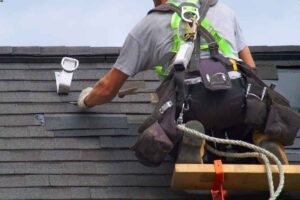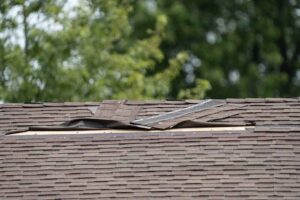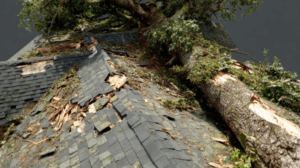Every year, as summer gives way to fall, North Carolina homeowners feel that familiar mix of anxiety and vigilance. The Atlantic starts brewing storms, weather alerts pop up on phones, and the phrase “tropical system moving inland” makes the rounds on the evening news.
If you live anywhere from the Sandhills to the Triangle, you already know—hurricane season doesn’t just threaten the coast. Even hundreds of miles inland, the combination of high winds, torrential rain, and flying debris can cause serious roof damage. And once a roof gives way, it’s open season on everything underneath it—your home, your comfort, your peace of mind.
At Red Wolf Roofing, we’ve spent years helping Central and North Carolina homeowners rebuild and reinforce their homes after storms. But the truth is, most of that damage could have been prevented with the right preparation. Roof weather-resilience isn’t luck—it’s strategy, craftsmanship, and knowing how to make your roof ready for whatever Mother Nature throws its way.
Let’s talk about what that really means.
The Real Threat Hurricanes Bring to Central and North Carolina
It’s easy to think hurricanes only affect coastal communities, but once those storms hit land, they don’t just fizzle out—they spread. The Sandhills, Piedmont, and even mountain regions see powerful remnants every season.
Here’s what homeowners should expect:
- High winds: Gusts often exceed 60 mph inland, easily strong enough to lift shingles or pull flashing loose.
- Driving rain: Water is forced up under shingles and into vulnerable roof valleys or joints.
- Falling debris: Branches, limbs, and airborne debris can puncture shingles or damage gutters and vents.
- Prolonged saturation: Heavy rain can overwhelm gutters, cause pooling, and lead to leaks through the decking.
The combination of wind and water creates the perfect storm (literally) for roof failure. And while you can’t control the weather, you can control how well your roof is prepared to handle it.
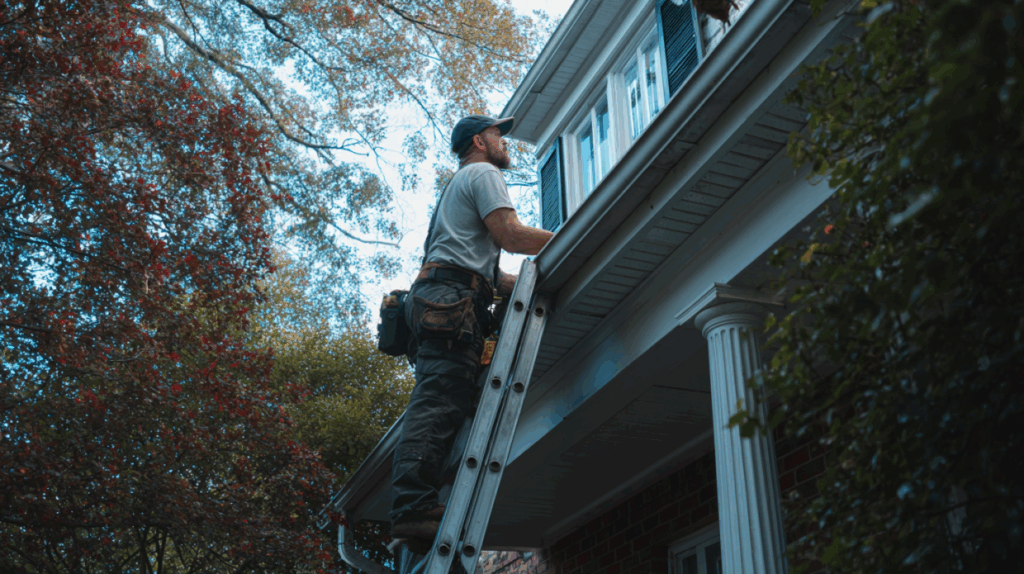
Step One: Start with a Professional Roof Inspection
Think of your roof like armor—it’s only as strong as its weakest link. Even a small crack or loose shingle can turn into a major failure point once hurricane-force winds start pulling.
That’s why the first and most important step in storm preparation is a thorough, professional inspection. At Red Wolf Roofing, we don’t just look at your shingles—we examine the entire system:
- Shingle integrity: We check for missing, lifted, or cracked shingles that could blow off during high winds.
- Flashing and sealant: Loose or corroded flashing around chimneys and vents is one of the top causes of storm leaks.
- Gutters and downspouts: Poor drainage leads to water backup and roofline damage during heavy rain.
- Decking condition: Soft or sagging areas underfoot often indicate hidden rot or water damage.
- Ridge caps and vents: These areas face the most wind exposure and often take the first hit in a storm.
Catching these vulnerabilities early gives you time to make repairs and strengthen your roof before the first storm rolls through.
Step Two: Reinforce What You Already Have
Not every home needs a full roof replacement before hurricane season, but every roof can benefit from reinforcement. Even small upgrades can drastically improve your home’s ability to withstand wind and water.
Here are a few of the most effective ways to strengthen your existing system:
- Re-nail or re-seal loose shingles: This prevents them from catching wind uplift during gusty storms.
- Upgrade to wind-rated shingles: If your roof is nearing replacement age, consider shingles tested for 110+ mph winds.
- Add roofing cement at vulnerable seams: Especially near valleys, ridges, and flashing—these areas often leak first.
- Secure gutters and fascia boards: High winds can rip them loose, pulling away part of your roof’s edge in the process.
- Install hurricane clips or straps: These fasteners help tie your roof structure more securely to the home’s framing.
These upgrades don’t just prevent catastrophic failure—they extend your roof’s lifespan and give you confidence heading into storm season.
Step Three: Focus on Proper Ventilation and Drainage
A weather-resistant roof isn’t just about keeping water out—it’s also about managing air and moisture properly once the rain begins.
When hot air and humidity build up inside your attic, it puts pressure on your roofing materials and encourages mold growth. During a hurricane or tropical storm, that trapped moisture can make things even worse, softening wood and reducing your roof’s ability to withstand stress.
Here’s what you can do:
- Inspect ridge and soffit vents: Make sure they’re clear of debris and properly sealed to keep rain from blowing in.
- Clean gutters and downspouts: Free-flowing drainage prevents water from pooling near your eaves and foundations.
- Add gutter guards: They reduce clogs during heavy rain and prevent overflow onto your roofline.
- Check attic insulation: Proper insulation reduces heat buildup, protecting shingles from premature aging.
The goal is simple—keep water moving off your roof quickly while allowing your attic to “breathe.”
Step Four: Choose Materials That Can Take the Hit
If your roof is already nearing the end of its lifespan, replacing it before hurricane season may be the smartest move you make this year. A worn-out roof won’t stand a chance against tropical weather.
When we install new roofs for homeowners in Central and North Carolina, we focus on materials that can handle our region’s unique climate—heat, humidity, and wind.
Some of our go-to recommendations include:
- Architectural shingles: These heavier, laminated shingles resist high winds better than traditional three-tab versions.
- Synthetic underlayment: Unlike old felt paper, modern synthetic barriers don’t absorb water or tear under stress.
- High-performance flashing systems: Aluminum or galvanized steel flashing resists corrosion and provides watertight protection at key seams.
- Impact-resistant shingles: Designed to withstand hail or flying debris, they’re perfect for storm-prone regions.
- Roof decking upgrades: Reinforcing or replacing weak decking ensures your entire roof has a strong foundation.
Quality materials don’t just survive storms better—they age better. Investing now means fewer emergency repairs down the road.
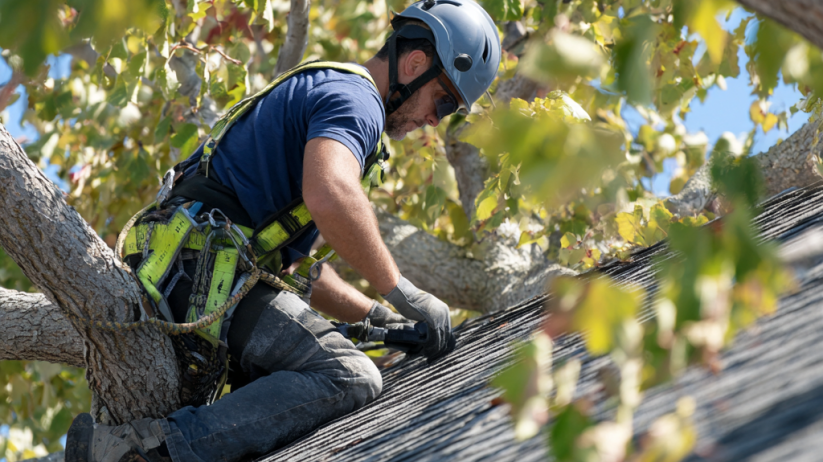
Step Five: Protect What’s Around the Roof
When prepping for hurricane season, don’t forget the surrounding elements that affect how your roof performs.
- Trim back overhanging branches: Limbs rubbing against shingles or crashing down during storms cause major damage.
- Secure outdoor equipment: Patio furniture, grills, and decorations can become airborne and hit your roof during high winds.
- Check skylights and vents: Make sure seals are intact and no gaps exist where rain can push through.
- Inspect siding and fascia boards: Water intrusion around roof edges often starts where siding or fascia has deteriorated.
Your roof doesn’t stand alone—it works in tandem with gutters, trim, and landscaping to protect your home. Keeping these areas maintained gives your roof a fighting chance when the wind picks up.
The Hidden Costs of Ignoring Roof Weather-Resilience
Many homeowners wait until after a storm to think about their roof, but by then, it’s too late. What could’ve been a few hundred dollars in preventive maintenance often turns into thousands in repairs—or worse, a full replacement.
Here’s what ignoring roof preparation can cost you:
- Interior water damage: Leaks destroy insulation, drywall, and flooring, often before you even notice them.
- Mold and mildew growth: Once water seeps in, it spreads fast, leading to costly remediation.
- Energy inefficiency: Damaged roofs and poor ventilation drive up heating and cooling bills year-round.
- Insurance complications: Some insurers deny storm-related claims if neglect or pre-existing issues are found.
In short, investing in roof resilience now saves money, frustration, and headaches later.
Why North Carolina Homeowners Trust Red Wolf Roofing
When you’re facing hurricane season, you want a local team that knows the region—and the weather—inside and out. At Red Wolf Roofing, we’ve spent years helping homeowners across Central and North Carolina protect their homes from the elements.
We don’t just patch problems; we build systems that last. From high-wind shingle installations to precision flashing work and attic ventilation improvements, every project we take on is built around long-term protection and local expertise.
We understand what the Sandhills’ heat, humidity, and storms can do to a roof—and we know how to stop it.
Prepare Today, Sleep Easier Tomorrow
Hurricane season in North Carolina isn’t something you can avoid—but you can prepare for it. A weather-resilient roof doesn’t just survive storms; it protects your home, your investment, and your peace of mind.
If you haven’t had your roof inspected this year, now’s the time. The earlier you act, the more options you’ll have to strengthen your roof before the next storm rolls in.
At Red Wolf Roofing, we’re ready to help. Our team will inspect your roof, identify weak points, and create a customized plan to fortify your home against wind and water. Whether that means repairs, reinforcements, or a full replacement, we’ll make sure your roof is built to handle whatever this hurricane season has in store.
Don’t wait for the next storm warning to find out what your roof can’t handle. Contact Red Wolf Roofing today to schedule your inspection and keep your home strong through every season—rain, shine, or hurricane.

